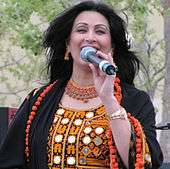Music of Afghanistan

Music has always been a part of Afghans' lives but since the late 1970s the country has been involved in constant wars and people were less concerned about music. As such, music in Afghanistan has been suppressed and recording for outsiders is minimal, despite a rich musical heritage.
Located on the crossroads between many trade routes, Afghanistan's music tradition was influenced by Arabs, Persians, Indians, Mongolians, Chinese and many others passing through. Thus Afghan music features a mix of Persian melodies, Arab scales, Indian compositional principles as well as sounds from ethnic groups such as the Pashtuns or Tajiks and the instruments used range from Indian tablas to long-necked lutes. It is worth noting that the most influential musical tradition in the subcontinent--the Indian musical tradition--owes a significant debt to Afghanistan.
During the 1990s, the Taliban governments banned instrumental music and much public music-making.[1] In spite of arrests and destruction of musical instruments, musicians have continued to play their trade into the present. The multi-ethnic city of Kabul has long been the regional cultural capital, but outsiders have tended to focus on the city of Herat, which is home to traditions more closely related to Iranian music than in the rest of the country.[2] Lyrics throughout most of Afghanistan are typically in Dari (Persian) and Pashto.
Folk and traditional music
Religious music
The Afghan concept of music is closely associated with instruments, and thus unaccompanied religious singing is not considered music. Koran recitation is an important kind of unaccompanied religious performance, as is the ecstatic Zikr ritual of the Sufis which uses songs called na't, and the Shi'a solo and group singing styles like mursia, manqasat, nowheh and rowzeh. The Chishti Sufi sect of Kabul is an exception in that they use instruments like the rubab, tabla and harmonium in their worship; this music is called tatti ("food for the soul").[3]
Classic

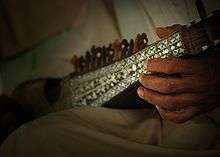
There is no single, but many musical traditions and styles in Afghanistan. These different traditions and styles evolved over centuries in the context of a highly diverse ethnic, linguistic, regional, religious, and class distinctions which characterized Afghan society. Afghan music can be classified in a number of ways. Although it is common practice to classify Afghan music into linguistic & regional lines (i.e. Pashtu, Farsi, Logari, Shomali etc), a more technically appropriate classification would be to distinguish various forms of Afghan music purely by their musical style. Thus, Afghan music can be mainly divided into four categories: Indian classical, Mohali (folk & regional styles), Western, and another style unique to Afghanistan itself (however, mainly adopted by Farsi musicians) simply called Afghan music.
The Indian classical tradition was a hugely influential strain. The vast majority of the elite artists in Afghanistan until 1980s were trained in the Indian classical tradition. Ustad Sarahang, Rahim Bakhsh, Ustad Nashenas and many other singers were prominent adherents of this style. This style emphasized compositions in the Indian raga style & the singing of Ghazals in melodies very similar to Indian classical & court music. The classical musical form of Afghanistan is called klasik, which includes both instrumental and vocal and belly dancing ragas, as well as Tarana and Ghazals.[4] Many Ustads, or professional musicians, have learned North Indian classical music in India, and some of them were Indian descendants who moved from India to the royal court in Kabul in the 1860s.[3] They maintain cultural and personal ties with India—through discipleship or intermarriage—and they use the Hindustani musical theories and terminology, for example raga (melodic form) and tala (rhythmic cycle). Afghanistan's classical singers include the late Ustad Mohammad Hussain Sarahang (1924-1983), who is one of the master singers of Patiala Gharana in North Indian classical music and is also well known throughout India and Pakistan as a contemporary of Ustad Bade Ghulam Ali Khan. His composition "Pai Ashk" was used in the theme song of the Hindi film Mera Saya. Ubaidullah Jan Kandaharai is regarded as the king of Pashto music in the southern Afghanistan region. He died in the 1980s but his music is still very much enjoyed by the Pashtun diaspora around the world, mainly by the Pashtuns in the Kandahar-Quetta regions. Other classical singers are Ustad Qasim, Ustad Rahim Bakhsh, and Ustad Nato.
The second group, Mohali (folk) music was more diverse. It contained various folkloric & regional styles which had evolved indigenously without outside influence. These styles include Qataghani, Logari, Qarsak etc which are specific to a region & linguistic group in Afghanistan. Some prominent artists in this category were Hamahang, Beltoon etc. Many other singers, however, who do not belong to this genre, have dabbled in recording songs in the Qataghani, logari, qarsak etc styles. Each of these forms had its own scale (they did not use the classical indian raga scale, nor did they use the western major/minor scale) and mainly consisted of well known songs whose composition and lyrics had evolved organically over centuries. These lyrics, though deep, were often simple and lacked the poetic sophistication of the great Farsi & Pashtu poetical traditions.
The third and most popular musical traditions in Afghanistan are the Pashtu (which belongs to the folk & indian classical tradition simultaneously), and the pure Afghan musical style. The pure Afghan musical style was popularized by the immortal Afghan singer Ahmad Zahir. This style is primarily popular with the Farsi/Dari speaking audience and it transcends any regional and class barriers. The style borrows from many other musical traditions such as the indian, iranain, middle eastern, folkloric Afghan traditions etc, but it fuses all these styles into a sound that is unique to Afghanistan and suits the lyrical, poetic, rhythmic, and orchestral tastes of the Afghan Farsi/Dari speaking audience. The vast majority of Farsi speaking singers since the 1970s belong to this genre. Apart from Ahmad Zahir, the most successful contemporary proponent of this style of Farhad Darya. However, the progenitor of this musical tradition was another Afghan singer named Abdul Rahim Sarban. Sarban's songs set the template for the unique Farsi Afghan musical sound that characterizes the most popular Afghan musical genre today. Sarban chose poetry from the great classical Farsi/Dari poets & set them to compositions which incorporated elements of the western jazz and belle chanson with the mohali (regional) traditions of Afghanistan. Up until then, Afghanistan had been mainly a borrower of styles from Iran, India & other countries. With Sarban's arrival, Afghan music reach such a height that renown artists from major cultural centres such as Iran borrowed his songs & covered them for their audiences (for instance Iran's immortal singer Googoosh covered a number of Sarban's songs most famously his "Ay Sarban Ahesta Ran").
Sarban's musical style was effectively adopted by Ahmad Zahir, Ahmad Wali, Nashenas, Afsana, Seems Tarana, Jawad Ghaziyar, Farhad Darya, & numerous other Afghan Farsi singers & transformed into a genuine recognizable Afghan musical style that is as easily recognizable as Flamenco is as a Spanish musical style, & Mariachi is a Mexican musical style.
The this form, Western music (mainly consisting of pop, and nowadays rap etc), is influenced mainly by the western musical tradition. However, in spite of its modernity, it is not the most popular musical genre. Many singers including Ahmad Zahir have sung in this tradition (pop, rock n roll etc). Most recently, there has been a blooming of rap & hip hop scene in Afghanistan as well. However, the western musical influence on Afghan music continues to be only in the fields of instrumentation & orchestration; Afghan musicians tent to choose musical language & compositions which belong to indigigenous Afghan musical forms but they use western musical instruments (such as drums, percussions, guitars etc) to orchestrate their music. there are very few musicians who compose in the western musical tradition as well.
Rubab
The rubab is a common lute-like instrument in Afghanistan, and is the forerunner of the Indian sarod.[2] The rubab is sometimes considered the national instrument of Afghanistan, and is called the "lion of instruments";[5] one reviewer claims it sounds like "a Middle Eastern predecessor to the blues that popped up in the Piedmont 100 years ago".[6] The rubab has a double-chambered body carved from mulberry wood, which is chosen to give the instrument its distinct timbre. It has three main strings and a plectrum made from ivory, bone or wood.
Famous players of the rubab are Mohammad Omar his famous student Sardar Mado of Qargha-Kabul, now is Sardar Mado, while modern performers include Essa Kassemi, Homayun Sakhi, and Mohammed Rahim Khushnawaz.[2]
Dombura
The dombura is a popular folk instrument, particularly among the northern Tajiks and the Hazaras in the central part of the country. Notable Afghan dombura players include Dilagha Surood, Naseer Parwani, Mir Maftoon, Safdar Tawkloi and Rajab Haideri. The dombura is played with much banging and scratching on the instrument to help give a percussive sound. The two strings are made of nylon (in modern times) or gut. They cross a short bridge to a pin at the other end of the body. There is a tiny sound hole in the back of the instrument, while the top is thick wood. It is not finished with any varnish, filing or sanding of any kind, and as with all other Afghan instruments there is some decoration.[7]
Ghichak
Ghichak is a string instrument made by the Hazara people of Afghanistan
Pop music
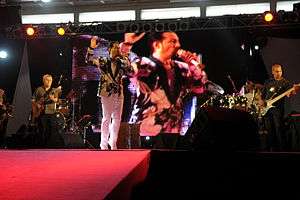
In 1925, Afghanistan began radio broadcasting, but its station was destroyed in 1929. Broadcasting did not resume until Radio Kabul opened in 1940.[8] As Radio Afghanistan reached the entire country, popular music grew more important. In 1951, Parwin became the first Afghan woman to sing live in Radio. Farida Mahwash, one of the famous female singers who then gained the title of Ustad (Master), had a major hit with "O bacheh" in 1977; she was "perhaps the most notable" of pop singers.[9]
Modern popular music did not arise until the 1950s when radio became commonplace in the country. They used orchestras featuring both Afghan and Indian instruments, as well as European clarinets, guitars and violins. The 1970s were the golden age of Afghanistan's music industry. Popular music also included Indian and Pakistani cinema film and music imported from Iran, Tajikistan, the Arab world and elsewhere.[3]
There is also a thriving Afghan music industry in neighboring Pakistan, primarily located in the cities of Peshawer, Karachi and the capital city, Islamabad. Much of the Afghan music industry was preserved via circulation in Pakistan and the holding of concerts for Afghan performers there which helped to keep the industry alive. Afghan performers regularly perform on Pakistani television programs and hold concerts throughout the country for the estimated 3-4 million Afghans that still live there.
Since the 2001 US intervention in Afghanistan and the removal of the Taliban, the music scene has begun to re-emerge. Some groups, like the Kaboul Ensemble, have gained an international reputation.[1] In addition, traditional Pashtun music (especially in the southeast of the country) has entered a period of "golden years", according to a prominent spokesman for Afghan Ministry of Interior, Lutfullah Mashal.[10]
History of pop
Pop music emerged in Afghanistan during the 1950s, and became very popular until the late 1970s. What helped the emergence of pop music in Afghanistan were amateur singers from non-traditional music backgrounds who wanted to showcase their talents in the studio (Radio Kabul). These singers were from middle- to upper-class families and were more educated than singers from traditional music backgrounds.
These amateurs innovated in Afghan music and created a more modern approach to the traditional folklore and classical music of Afghans. Amateur singers included Farhad Darya (the legend of Afghan's today music), Ahmad Zahir, Nashinas (Dr. Sadiq Fitrat) Ahmad Wali, Zahir Howaida, Rahim Mehryar, Mahwash, Haidar Salim, Ehsan Aman, Najim Nawabi, Salma Jahani, Sharif Ghazal, Hangama, Parasto, Naghma, Mangal, Farhad Darya, Sarban, and others. Ahmad Zahir was among Afghanistan's most famous singers; throughout the 60s and 70s he gained national and international recognition in countries like Iran and Tajikistan.
Rock music is slow to gain a foothold in the country, and Kabul Dreams is one of the few Afghan rock bands; formed in 2008 by ex-pats, they claim to be the first one.[11]
Afghan hip hop
Afghan hip hop is a type of music popular among Afghanistan's youth and immigrant community.[12] It inherits much of the style of traditional hip hop, but puts added emphasis on rare cultural sounds. Afghan hip hop is mostly sung in Dari (Persian), Pashto, and English. One popular hip hop artist is DJ Besho (Bezhan Zafarmal), a resident of Kabul. Another is 'Awesome Qasim', who is known in Canada and raps in Farsi, Pashto, and English. Qasim's most recent album came out in February 2013 in Canada.[13][14] Kabul musician Soosan Firooz has been described as Afghanistan's first female rapper.[15] Sonita Alizadeh is another female Afghan rapper, who has gained notoriety for writing music protesting forced marriages.[16]
Gallery
 Minstrels, Herat, 1973
Minstrels, Herat, 1973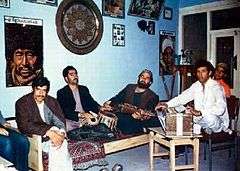 Afghan musicians, Herat 1973
Afghan musicians, Herat 1973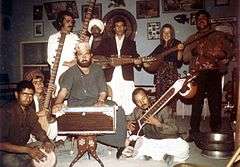 Musicians in Herat, Afghanistan in 1973
Musicians in Herat, Afghanistan in 1973
See also
References
- "Muted Musicians See Hope in Young Performers". Inter Press Service. 2005-02-26. Retrieved November 21, 2008.
- "Afghanistan". Almaty or Bust. Retrieved August 27, 2005.
- Jacinto, Leela (2005-05-22). "The Tale of the Pashtun Poetess". Boston Globe. Retrieved August 27, 2005.
- "Review of Anthology of World Music: The Music of Afghanistan". Delusions of Adequacy Reviews. Archived from the original on April 17, 2005. Retrieved January 28, 2006.
- Doubleday, Veronica. "Red Light at the Crossroads". 2000. In Broughton, Simon and Ellingham, Mark with McConnachie, James and Duane, Orla (Ed.), World Music, Vol. 2: Latin & North America, Caribbean, India, Asia and Pacific, pp 3–8. Rough Guides Ltd, Penguin Books. ISBN 1-85828-636-0
- "Afghan Music Before the War". Mikalina. Archived from the original on November 4, 2005. Retrieved August 27, 2005.
Notes
- 1 2 Almaty or Bust
- 1 2 3 Doubleday, pg. 4
- 1 2 3 Mikalina
- ↑ Doubleday, pg. 3
- ↑ Doubleday, pg. 4 "Afghans have a special feeling for the rubab, describing it as their 'national instrument'."
- ↑ Delusions of Adequacy Reviews
- ↑ Atlas of plucked instruments - Central Asia
- ↑ Mikalina Radio broadcasting was initiated in 1925 during the reign of Amanullah. The radio station was destroyed in 1929 in the uprising against his modernist policies, and there was no serious attempt to resume radio transmissions until Radio Kabul was officially opened in 1940, with German equipment and assistance.
- ↑ Doubleday, pgs. 4-5
- ↑ Boston Globe
- ↑ Najib, Moska (5 January 2010). "Afghan dreams of rock and roll". BBC Online. Retrieved 21 February 2014.
- ↑ Coghlan, Tom (2006-05-10). "Gangsta Rap, Afghan Style". BBC. Retrieved 2007-03-06.
- ↑ Albone, Tim (2006-04-24). "Gangsta rapper of Kabul puts peace before guns 'n' girls". London: The Times. Retrieved 2007-03-06.
- ↑ Saboor, Abdul (2006-05-16). "Afghan rapper wins fans with message of peace". Reuters. Retrieved 2010-02-02.
- ↑ Yousafzai, Sami; Moreau, Ron (4 January 2013). "Susan Feroz: Afghanistan’s First Female Rapper". Newsweek.
- ↑ Bloom, Deborah (October 12, 2015). "Afghan teen uses rap to escape forced marriage". CNN. Retrieved October 23, 2015.
Further reading
- Baily, John and John Blacking (1988). Music of Afghanistan: Professional Musicians in the City of Herat. Cambridge University Press. ISBN 0-521-25000-5.
- Sakata, Hiromi Lorraine (1983). Music in the Mind: The Concepts of Music and Musician in Afghanistan. Kent State University Press. ISBN 0-87338-265-X.
- Slobin, Mark (1976). Music in the Culture of Northern Afghanistan. University of Arizona Press. ISBN 0-8165-0498-9.
External links
- #1 Afghan Music & Entertainment Site Online
- Afghan Music & Entertainment Portal
- Audio clips - traditional music of Afghanistan. French National Library. Accessed November 25, 2010.
- Listen to Afghan Music Online
